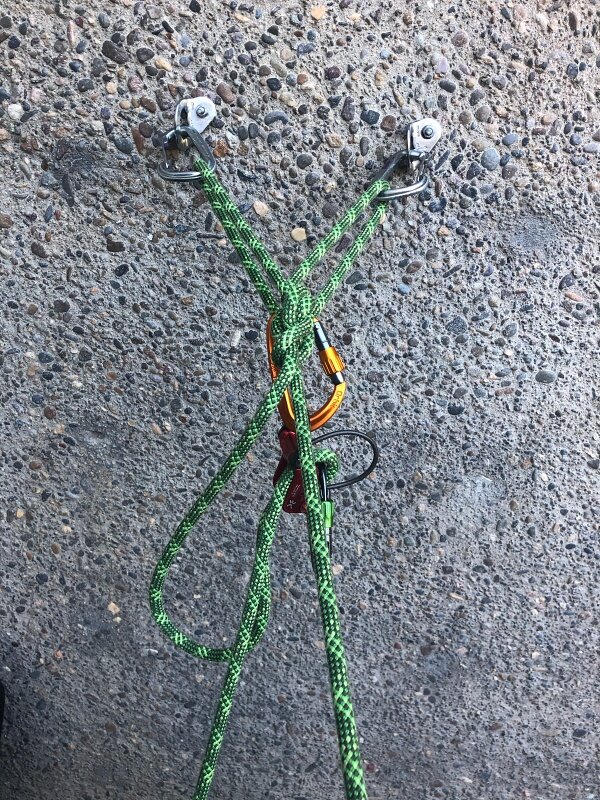Use the rope to make an anchor - 2 knots
Climbing multi pitch routes with bolted, side-by-side anchors? You might want to leave the cordelette and anchor slings at home. All you really need is the rope you’re attached to and two carabiners.
Many experienced climbers (like Peter Croft and Steph Davis) prefer this approach, because it's simple, clean, and requires less gear.
This can also be a good approach if the climbing is tough and run out right off of the anchor, and thus a greater chance for a leader fall to put a large amount of force onto the anchor and belay. Having the entire anchor made out of dynamic rope gives more stretch to the system and will lower the force on all the other components.
Because the leader is directly tied to the anchor, this generally works best of each partner is swinging leads every pitch. If you are not changing leads every pitch, it's usually easier to use a more standard sling or cordelette style anchor, because you have a single master point.
If you are going to use a rope anchor as described here, and are not changing leads, typically climbers will swap the ends of the rope at every belay. The easiest way to do this is to connect your harness to the rope ends with a figure 8 on a bight knot and two stout locking carabiners, rather than the standard rewoven figure 8 knot.)
Rescue geeks, I can hear you now: “But how are you going to escape the belay if you need to rescue your partner?” The answer is, yes, it’ll be a little more difficult, but you can do it. But, here’s a question to ponder - have you, or anyone you personally know, ever had to actually do this in real life? Climbers who use this method generally feel the simplicity, weight savings and lower cluster factor of tying in directly with the rope outweigh highly unlikely rescue scenarios.
There are many other options for using the rope to tie in directly. We cover one in another article, using just clove hitches, read about it here.
Here are two different knots you can use to tie directly to a two piece anchor.
1 - Bowline on a bight
This is my preferred technique. This is essentially a bowline knot with two loops rather than one. The knot is easy to learn, fast to tie, and easy to visually inspect to see if you did it right. You can adjust the size of each ear to equalize the anchor.
Typically, bowlines are not popular with many rope professionals for securing the end of a rope, because the knot can loosen up unexpectedly. However, in this application the bowline works fine, because the end is secured to your harness and can’t possibly pull through the knot.
John Long tried to popularize this in one of his rock anchor books about 15 years ago, but it never really seem to catch on. Too bad, it's a great knot. Maybe it was the cheesy name I think he gave it, the “atomic clip”. Just call it a bowline on a bight; that’s the common name and describes it perfectly.
Here’s a video showing how to tie a bowline on a bight.
Here's what it looks like, from the leader’s point of view.
You can clip your belay carabiner to the shelf (both of the loops to go to the bolts) to bring up your partner.
2 - “Bunny ears” Figure 8
This is a variation on the figure 8, familiar to every climber. This might take a little practice to tie neatly with no twists, and to get the length of the loops correct. This knot is popular with professional ropeworkers, who use it to secure one end of a fixed rope. (Tip: start with a larger bight than you think you need to, at least 2 feet.)
This knot has a cool feature of being able to slide the “ears” to two different lengths, to accommodate one bolt that may be a little higher than the other. This is actually sort of magical, you just need to play with it to see how it works. You need to do this when the knot is relatively loose. After you snug it down, the “slide” feature does not work.
One more thing: some people think that the bunny ears figure 8 is not redundant, meaning that if one strand were to be cut, it could conceivably pull through and the knot would fail. This has been tested many times and does not happen, so yes, the knot is redundant.
Here's a short article that covers it nicely, from Australian rigging expert Rich Delaney and Ropelab.
Here’s a video showing how to tie a bunny ears figure 8, by expert climber Beth Rodden. (She calls at the “super 8”, same thing.(
Here's what it looks like, from the leader’s point of view.
Same as with the bowline on a bight, you can clip your belay carabiner to the shelf to bring up your partner.




